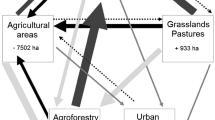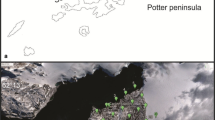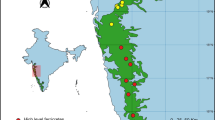Abstract
While higher plant communities found on ultramafics are known to display peculiar characteristics, the distinguishability of any peculiarity in lichen communities is still a matter of contention. Other biotic or abiotic factors, rather than substrate chemistry, may contribute to differences in species composition reported for lichens on adjacent ultramafic and non-ultramafic areas. This work examines the lichen biota of ultramafics, at global and regional scales, with reference to species-specific functional traits. An updated world list of lichens on ultramafic substrates was analyzed to verify potential relationships between diversity and functional traits of lichens in different Köppen–Geiger climate zones. Moreover, a survey of diversity and functional traits in saxicolous communities on ultramafic and non-ultramafic substrates was conducted in Valle d’Aosta (North-West Italy) to verify whether a relationship can be detected between substrate and functional traits that cannot be explained by other environmental factors related to altitude. Analyses (unweighted pair group mean average clustering, canonical correspondence analysis, similarity-difference-replacement simplex approach) of global lichen diversity on ultramafic substrates (2314 reports of 881 taxa from 43 areas) displayed a zonal species distribution in different climate zones rather than an azonal distribution driven by the shared substrate. Accordingly, variations in the frequency of functional attributes reflected reported adaptations to the climate conditions of the different geographic areas. At the regional scale, higher similarity and lower species replacement were detected at each altitude, independent from the substrate, suggesting that altitude-related climate factors prevail over putative substrate–factors in driving community assemblages. In conclusion, data do not reveal peculiarities in lichen diversity or the frequency of functional traits in ultramafic areas.







Similar content being viewed by others
References
Anacker BL (2014) The nature of serpentine endemism. Am J Bot 10:219–224. https://doi.org/10.3732/ajb.1300349
Aptroot A, John V (2015) An historical lichen collection from New Caledonia. Herzogia 28:307–321. https://doi.org/10.13158/heia.28.2.2015.307
Aptroot A, Van de Vijver B, Lebouvier M, Ertz D (2011) Lichens of Ile Amsterdam and Ile Saint Paul (TAAF, southern Indian Ocean). Nova Hedwigia 92:343–367. https://doi.org/10.1127/0029-5035/2011/0092-0343
Armstrong RA (1981) Field experiments on the dispersal, establishment and colonization of lichens on a slate rock surface. Environ Exp Bot 21:115–120. https://doi.org/10.1016/0098-8472(81)90016-2
Bilovitz PO, Mayrhofer H (2009) A contribution to the lichenized fungi of Bosnia and Herzegovina. Fritschiana (Graz) 65:53–56
Boustie J, Tomasi S, Grube M (2011) Bioactive lichen metabolites: alpine habitats as an untapped source. Phytochem Rev 10:287–307. https://doi.org/10.1007/s11101-010-9201-1
Brodo IM (1973) Substrate ecology. In: Ahmadjian V, Hale ME (eds) The lichens. Academic, New York, pp 401–441
Brooks RR (1987) Serpentine and its vegetation: a multidisciplinary approach. Dioscorides Press, Croom Helm
Candan M, Türk AO (2008) Lichens of Malatya, Elazığ and Adıyaman provinces (Turkey). Mycotaxon 105:19–22
Clauzade G, Roux C (1985) Likenoj de Okcidenta Europo. Ilustrita determinlibro. Bull Soc Bot Centre-Ouest 7:3–893
Consortium of North American Lichen Herbaria (CNALH) (2017) http://lichenportal.org/portal/. Accessed 9 Sept 2017
Deduke C, Halden NM, Piercey-Normore MD (2016) Comparing element composition of rock substratum with lichen communities and the fecundity of Arctoparmelia and Xanthoparmelia species. Botany 94:41–51. https://doi.org/10.1139/cjb-2015-0141
Divakar PK, Crespo A (2015) Molecular phylogenetic and phylogenomic approaches in studies of lichen systematics and evolution. In: Upreti DK, Divakar PK, Shukla V, Bajpai R (eds) Recent advances in lichenology. Modern methods and approaches in lichen systematics and culture techniques, vol 2. Springer, New Delhi, pp 45–60
Elix JA, Stocker-Wörgötter E (2008) Biochemistry and secondary metabolites. In: Nash TH III (ed) Lichen biology. Cambridge University Press, Cambridge, pp 104–133
Favero-Longo SE (2014) Lichens on metal-rich substrates. In: Rajakaruna N, Boyd R, Harris T (eds) Plant ecology and evolution in harsh environments. Nova Publishers, New York, pp 53–76
Favero-Longo SE, Piervittori R (2009) Measuring the biodiversity of saxicolous lichens above timberline with reference to environmental factors: the case-study of a Natura 2000 site of western Alps. Phytocoenologia 39:51–78. https://doi.org/10.1127/0340-269X/2009/0039-0051
Favero-Longo SE, Isocrono D, Piervittori R (2004) Lichens and ultramafic rocks: a review. Lichenologist 36:391–404. https://doi.org/10.1017/S0024282904014215
Favero-Longo SE, Siniscalco C, Piervittori R (2006) Plant and lichen colonization in an asbestos mine: spontaneous bioattenuation limits air dispersion of fibres. Plant Biosyst 140:190–205. https://doi.org/10.1080/11263500600756546
Favero-Longo SE, Matteucci E, Morando M, Rolfo F, Harris T, Piervittori R (2015) Metals and secondary metabolites in saxicolous lichen communities on ultramafic and non-ultramafic rocks of the Western Italian Alps. Austral J Bot 63:276–291. https://doi.org/10.1071/BT14256
Fryday AM (2005) The genus Porpidia in northern and western Europe, with special emphasis on collections from the British Isles. Lichenologist 37:1–35. https://doi.org/10.1017/S0024282904014628
Gallo LM, Piervittori R (1991) La flora lichenica rupicola dei Monti Pelati di Baldissero (Canavese, Piemonte). In: Giachino PM (ed) I Monti Pelati di Baldissero. Importanza paesistica e scientifica. Atti Convegno 1991, pp. 25–31
Galloway DJ (2009) Lichen biogeography. In: Nash TH III (ed) Lichen biology. Cambridge University Press, Cambridge, pp 315–335
Gilbert OL (1983) The lichens of Rhum. Trans Bot Soc Edinb 44:139–149. https://doi.org/10.1080/03746608308685380
Gilbert OL, James PW (1987) Field meeting on the Lizard Peninsula, Cornwall. Lichenologist 19:319–334. https://doi.org/10.1017/S0024282987000288
Giordani P, Modenesi P, Tretiach M (2003) Determinant factors for the formation of the calcium oxalate minerals, weddellite and whewellite, on the surface of foliose lichens. Lichenologist 35:255–270. https://doi.org/10.1016/S0024-2829(03)00028-8
Giordani P, Benesperi R, Rizzi G, Brunialti G (2009) New records for lichen regional floras of Italy. Webbia 64:153–158. https://doi.org/10.1080/00837792.2009.10670855
Giordani P, Brunialti G, Bacaro G, Nascimbene J (2012) Functional traits of epiphytic lichens as potential indicators of environmental conditions in forest ecosystems. Ecol Indic 18:413–420. https://doi.org/10.1016/j.ecolind.2011.12.006
Giordani P, Incerti G, Rizzi G, Rellini I, Nimis PL, Modenesi P (2014) Functional traits of cryptogams in Mediterranean ecosystems are driven by water, light and substrate interactions. J Veg Sci 25:778–792. https://doi.org/10.1111/jvs.12119
Giordani P, Rizzi G, Caselli A, Modenesi P, Malaspina P, Mariotti MG (2016) Fire affects the functional diversity of epilithic lichen communities. Fungal Ecol 20:49–55. https://doi.org/10.1016/j.funeco.2015.11.003
Hafellner J (1991) Die Flechtenflora eines hochgelegenen Serpentinitstockes in den Östalpen (Österreich, Steiermark). Mitt Naturwiss Vereins Steiermark Graz 121:95–106
Hafellner J (2001) Bemerkenswerte Flechtenfunde in Österreich. Fritschiana 28:1–30
Hakulinen R (1958) Jäkäliä Suomen serpentiinikallioilta. Ann Bot Soc Zool-Bot Fenn “Vanamo” 12:143–145
Hansen CJ, Goertzen LR (2012) Psora icterica (Lecanorales, Psoraceae), a new and interesting disjunction from Alabama. Opuscula Philolichenum 11:49–51
Harris TB, Olday FC, Rajakaruna N (2007) Lichens of Pine Hill, a peridotite outcrop in eastern North America. Rhodora 109:430–447. https://doi.org/10.3119/0035-4902(2007)109[430:LOPHAP]2.0.CO;2
Harrison S, Rajakaruna N (2011) Serpentine. The evolution and ecology of a model system. University of California Press, Berkeley
Hauck M, Huneck S, Elix JA, Paul A (2007) Does secondary chemistry enable lichens to grow on iron-rich substrates? Flora 202:471–478. https://doi.org/10.1016/j.flora.2006.08.007
Hauck M, Jürgens S-R, Willenbruch K, Huneck S, Leuschner C (2009) Dissociation and metal-binding characteristics of yellow substances suggest a relationships with site preferences of lichens. Ann Bot 103:13–22. https://doi.org/10.1093/aob/mcn202
Hauck M, Böning J, Jacob M, Dittrich S, Feussner I, Leuschner C (2013) Lichen substance concentrations in the lichen Hypogymnia physodes are correlated with heavy metal concentrations in the substratum. Environ Exp Bot 85:58–63. https://doi.org/10.1016/j.envexpbot.2012.08.011
Huneck S, Yoshimura I (1996) Identification of lichen substances. Springer, Berlin
Index Fungorum (2017) http://www.indexfungorum.org/. Accessed 9 Sept 2017
Isocrono D, Favero Longo SE, Piervittori R (2008) La flora lichenica del Parco Naturale del Mont Avic (Valle d’Aosta, Italia). Rev Valdôtaine Hist Nat 62:77–93
Kantvilas G (1991) Records of east African lichens in cool temperate Australia. Nordic J Bot 11:369–373. https://doi.org/10.1111/j.1756-1051.1991.tb01416.x
Kocakaya M, Halici MG, Aksoy A (2014) Lichenized and lichenicolous fungi of Gevne Valley (Konya, Antalya). Turk J Bot 38:358–369. https://doi.org/10.3906/bot-1303-29
Kossowska M (2001) Epilithic lichens on serpentinite rocks in Poland. Pol Bot J 46:191–197
Kottek M, Grieser J, Beck C, Rudolf B, Rubel F (2006) World map of the Köppen–Geiger climate classification updated. Meteorol Z 15:259–263. https://doi.org/10.1127/0941-2948/2006/0130
Krause W, Klement O (1958) Zur Kenntnis der Flora und Vegetation auf Serpentinstandorten des Balkans. 3. Felsflechten-Gesellschaften im Gosrovic-Gebiet (Bosnien) und Zlatibor-Gebirge (Serbien). Vegetatio 8:1–19
Krause W, Klement O (1962) Zur Kenntnis der Flora und Vegetation aus Sepentinstandorten des Balkans. 5. Flechten und Flechtengesellschaften auf Nord-Euboa (Geiechenland). Nova Hedwigia 4:189–262
Kretschmer L (1931) Die Pflanzengesellschaften auf Serpentin im Gurhofgraben bei Melk. Verh Zool-Bot Ges Wien 80:163–208
Krzewicka B (2009) The ‘Verrucaria fuscella group’ in Poland with some nomenclatorial remarks. Acta Soc Bot Poloniae 78:229–234. https://doi.org/10.5586/asbp.2009.029
Lammermayr L (1934) Überinstimmung und Unterschiede in der Pflanzendecke über Serpentin und Magnesit. Mitteilungen der Naturwissenschaftlichen Vereins für Steiermark, Graz 71:41–62
Malpas J (1992) Serpentine and the geology of serpentinized rocks. In: Roberts A, Proctor J (eds) The ecology of areas with serpentinized rocks. A world view. Kluwer Academic Publishers, Dordrecht, pp 7–30
Matteucci E, Bovero B, Vanacore Falco I, Piervittori R (2015) Comunità licheniche rupicole in Valle d’Aosta: confronti a quote differenti. Rev Valdôtaine Hist Nat 69:61–77
Matteucci E, Occhipinti A, Piervittori R, Maffei ME, Favero-Longo SE (2017) Morphological, secondary metabolite and ITS (rDNA) variability within usnic acid-containing lichen thalli of Xanthoparmelia explored at the local scale of rock outcrop in W-Alps. Chem Biodivers 14:e1600483. https://doi.org/10.1002/cbdv.201600483
Medeiros ID, Fryday AM, Rajakaruna N (2014) Additional lichen records and mineralogical data from metal-contaminated sites in Maine. Rhodora 116:323–347. https://doi.org/10.3119/13-26
Morando M, Favero-Longo SE, Carrer M, Matteucci E, Nascimbene J, Sandrone S, Appolonia L, Piervittori R (2017) Dispersal patterns of meiospores shape population spatial structure of saxicolous lichens. Lichenologist 49:397–413. https://doi.org/10.1017/S0024282917000184
Nash TH III (2008) Lichen biology. Cambridge University Press, Cambridge
Nelson PR, McCune B, Roland C, Stehn S (2015) Non-parametric methods reveal non-linear functional trait variation of lichens along environmental and fire age gradients. J Veg Sci 26:848–865. https://doi.org/10.1111/jvs.12286
Nguyen KH, Chollet-Krugler M, Gouault N, Tomasi S (2013) UV-protectant metabolites from lichens and their symbiotic partners. Nat Prod Rep 30:1490–1508. https://doi.org/10.1039/C3NP70064J
Nimis PL (1996) Towards a checklist of Mediterranean lichens. Bocconea 6:5–17
Nimis PL (2016) The lichens of Italy. A second annotated catalogue. EUT, Trieste
O’Dell RE, Rajakaruna N (2011) Intraspecific variation, adaptation, and evolution. In: Harrison S, Rajakaruna N (eds) Serpentine. The evolution and ecology of a model system. University of California Press, Berkeley, pp 97–137
Palmqvist K (2000) Tansley review no. 117: carbon economy in lichens. New Phytol 148:11–36. https://doi.org/10.1046/j.1469-8137.2000.00732.x
Paukov AG (2009). The lichen flora of serpentine outcrops in the Middle Urals of Russia. N E Nat 16 (Special Issue No. 5):341–350
Paukov AG, Trapeznikova SN (2005) Lithophilous lichens of Middle Urals. Folia Cryptog Estonica 41:81–88
Paukov A, Sipman HJM, Kukwa M, Repin R, Teptina A (2017) New lichen records from the mountains Kinabalu and Tambuyukon (Kinabalu Park, Malaysian Borneo). Herzogia 30:237–252
Peksa O (2011) Lišejníky národní přírodní památky Křížky. Sborník muzea Karlovarského kraje 19:259–272
Pichi-Sermolli R (1948) Flora e vegetazione delle serpentine e delle altre ofioliti dell’alta valle del Tevere (Toscana). Webbia 6:1–380. https://doi.org/10.1080/00837792.1948.10669585
Podani J (2001) SYN-TAX 2000. Computer programs for data analysis in ecology and systematics. User’s Manual. Scientia Publishing, Budapest
Podani J, Schmera D (2011) A new conceptual and methodological framework for exploring and explaining pattern in presence–absence data. Oikos 120:1625–1638. https://doi.org/10.1111/j.1600-0706.2011.19451.x
Poelt J (1975) Squamarina serpentinii species nova (Lichenes, Lecanoraceae) aus Serbien. Herzogia 3:425–432
Purvis OW, Halls C (1996) A review of lichens in metal-enriched environments. Lichenologist 28:571–601. https://doi.org/10.1006/lich.1996.0052
Rajakaruna N (2017) Lessons on evolution from the study of edaphic specialization. Bot Rev. https://doi.org/10.1007/s12229-017-9193-2
Rajakaruna N, Knudsen K, Fryday AM, O’Dell RE, Pope N, Olday FC, Woolhouse S (2012) Investigation of the importance of rock chemistry for saxicolous lichen communities of the New Idria serpentinite mass, San Benito County, California, USA. Lichenologist 44:695–714. https://doi.org/10.1017/S0024282912000205
Ritter-Studnička H, Klement O (1968) Über Flechtenarten und deren Gesellschaften auf Serpentin in Bosnien. Oesterr Bot Z 115:93–99
Rubel F, Brugger K, Haslinger K, Auer I (2017) The climate of the European Alps: shift of very high resolution Köppen–Geiger climate zones 1800–2100. Meteorol Z 26:115–125. https://doi.org/10.1127/metz/2016/0816
Ryan BD (1988) Marine and maritime lichens on serpentine rocks on Fidalgo Island, Washington. Bryologist 91:186–190. https://doi.org/10.2307/3243217
Sambo E (1927) I licheni del Monte Ferrato (Toscana). Nuovo Giornale Botanico Italiano 34:333–358
Sambo E (1937) Sull’azione vicariante del magnesio invece del calcio in licheni calcicoli di roccia alcalica. Nuovo Giorn Bot Ital 24:246–250. https://doi.org/10.1080/11263503709437956
Sánchez-Biezma MJ, López de Silanes ME (1999) Porpidia nadvornikiana, a species of ultrabasic rocks: second record for Europe. Lichenologist 31:637–639. https://doi.org/10.1006/lich.1999.0238
Sánchez-Biezma Serrano MJ, Alvarez Andrés J, de Silanes López, Vázquez ME (2001) Líquenes de las rocas ultamáficas en la Sierra de A Capelada (A Coruña, NW de España). Bot Complut 25:261–269
Sánchez-Biezma MJ, Carballal R, López de Silanes ME (1996) Algunos líquenes de rocas básicas y ultrabásicas nuevos para el nord de España. Cryptogamie Bryologie Lichénologie 17:203–211
Scheidegger C (2016) As thick as three in a bed. Mol Ecol 25:3261–3263. https://doi.org/10.1111/mec.13710/full
Seaward MRD (1977) Lichen ecology. Academic, London
Seymour FA, Crittenden PD, Dyer PS (2005) Sex in the extremes: lichen-forming fungi. Mycologist 19:51–58. https://doi.org/10.1017/S0269-915X(05)00201-6
Sigal LL (1989) The lichens of serpentine rocks and soils in California. Mycotaxon 34:221–238
Sipman HJM (1993) Lichens from Mount Kinabalu. Trop Bryol 8:281–314
Sirois L, Lutzoni F, Grandtner MM (1987) Les lichens sur serpentine et anphibolite du plateau du mont Albert, Gaspésie, Québec. Can J Bot 66:851–862. https://doi.org/10.1139/b88-124
Smith CW, Aptroot A, Coppins BJ, Fletcher A, Gilbert OL, James PW, Wolseley PA (2009) The lichens of Great Britain and Ireland. British Lichen Society, London
Suza J (1927) Lichenologický ráz západočeských serpentinů. Čas Morav Zemsk Mus 25:251–281
Takala K, Seaward MRD (1978) Lichens of the Niinivaara serpentinite region, E. Finland. Memoranda Soc Fauna Fl Fenn 54:59–63
Ter Braak CJF, Šmilauer P (2002) CANOCO reference manual and CanoDraw for Windows User’s guide:software for canonical community ordination (version 4.5). Microcomputer Power, Ithaca
Ter Braak CJ, Verdonschot PF (1995) Canonical correspondence analysis and related multivariate methods in aquatic ecology. Aquat Sci 57:255–289. https://doi.org/10.1007/BF00877430
van der Ent A, Baker AJ, Reeves RD, Pollard AJ, Schat H (2013) Hyperaccumulators of metal and metalloid trace elements: facts and fiction. Plant Soil 362:319–334. https://doi.org/10.1007/s11104-012-1287-3
Verseghy K (1974) Nachtrag II. zum “TypenVerzeichnis der Flechtensammlung in der Botanischen Abteilung des Ungarischen Naturwissenschaftlichen Museums”. Stud Bot Hung 9:23–29
Vězda A (1972) Haplocarpon nadvornikianum Vězda sp. nov. Preslia 44:208–212
Violle C, Navas ML, Vile D, Kazakou E, Fortunel C, Hummel I, Garnier E (2007) Let the concept of trait be functional! Oikos 116:882–892. https://doi.org/10.1111/j.0030-1299.2007.15559.x
von Brackel W (2007) Zur Flechtenflora der Serpentinitfelsen in Nordostbayern. Hoppea 68:253–268
Wirth V (1972) Die Silikatflechten Gemainschaften im ausseralpinen Zentraleuropa. Diss Bot 17:1–306
Wirth V (1995) Die Flechten. Baden-Württembergs. Ulmer, Stuttgart
Zahlbruckner A (1907) Aufzälung der von Dr. H. Bretzl in Griechenland gesammelten Flechten. Hedwigia 47:60–65
Zedda L, Rambold G (2015) The diversity of lichenised fungi: Ecosystem functions and ecosystem services. In: Upreti DK, Divakar PK, Shukla V, Bajpai R (eds) Recent advances in lichenology. Modern methods and approaches in lichen systematics and culture techniques, vol 2. Springer, New Delhi, pp 121–145
Acknowledgements
EM was the recipient of a postdoctoral fellowship (RICERCA FSE 2011–2012, funded by the European Union, Italian Ministry of Labour and Social Policies, Regione Autonoma Valle d’Aosta: agreement 10016/DPLF/28June2012). The authors are grateful to Bianca Bovero (University of Torino) for her assistance during fieldwork and to Rosanna Piervittori (University of Torino) for helpful discussions. The authors thank two reviewers for their useful and constructive comments which helped improve the quality of the manuscript. The work of AP is financially supported by RFBR (Grants 15-04-05971 and 16-04-01346).
Author information
Authors and Affiliations
Corresponding author
Electronic supplementary material
Below is the link to the electronic supplementary material.
About this article
Cite this article
Favero-Longo, S.E., Matteucci, E., Giordani, P. et al. Diversity and functional traits of lichens in ultramafic areas: a literature-based worldwide analysis integrated by field data at the regional scale. Ecol Res 33, 593–608 (2018). https://doi.org/10.1007/s11284-018-1573-5
Received:
Accepted:
Published:
Issue Date:
DOI: https://doi.org/10.1007/s11284-018-1573-5




